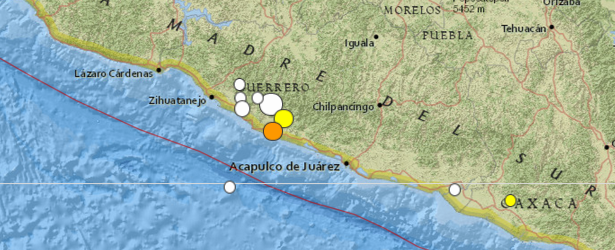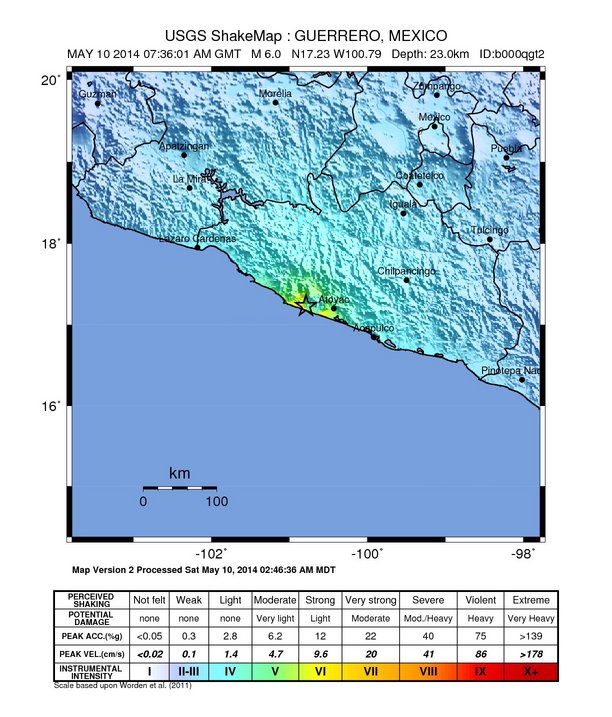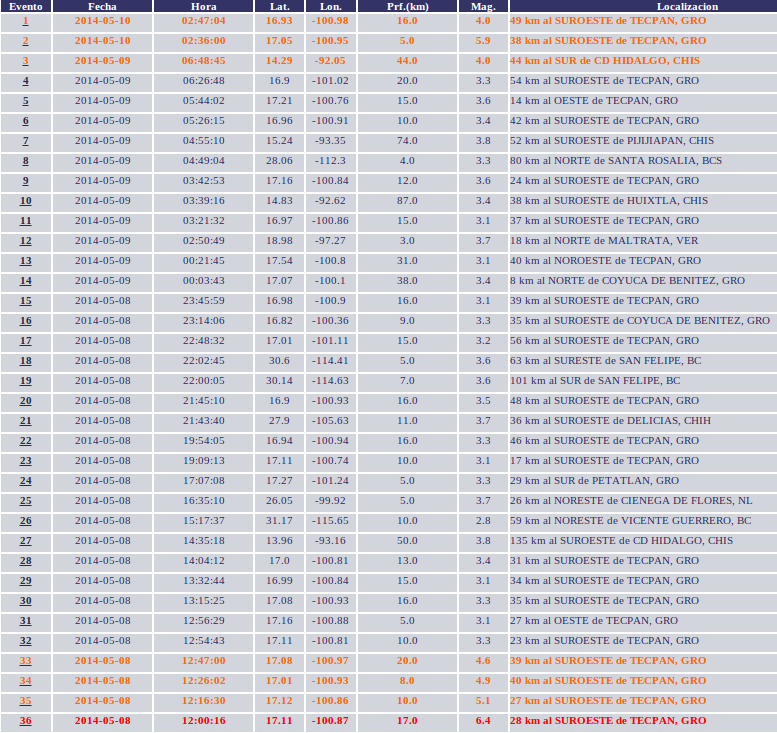Numerous moderate to strong aftershocks registered in Guerrero, southern Mexico

After M 7.2 earthquake that hit Mexico's southern state of Guerrero on April 18, 2014, the region was hit by numerous moderate to strong aftershocks.
Mexico's Servicio Seismologico Nacional (SSN) registered a total of 35 earthquakes since May 8th when strong M 6.4 earthquake occurred. On May 10 at 07:36 UTC, 02:36 am local time, the region was hit by another strong quake measuring M 5.9 (SSN) at depth of 5 km. USGS reports M 6.0 at depth of 23 km.
Epicenter was located about 11 km (7 miles) W of Tecpan de Galeana, 35 km (23 miles) of Atoyac de Alvarez and 299 km (186 miles) SW of capital Mexico City. There are about 428 513 people living within 100 km radius.
Power went out for a couple of minutes in some parts of Mexico City.
A lot of the damaged homes from the mainshock on April 18 resulted in complete loss, some of them even collapsed. Today’s aftershock will add to all this misery. Contrary to other countries, the Mexican authorities are not publishing detailed statistics about earthquake damage. (ER)
Panic in #Mexico as second strong quake strikes in 3 days http://t.co/3tU2uAdyYl pic.twitter.com/eZqZAHso1r
— RT (@RT_com) May 10, 2014


Earthquake list May 8 – 10, 2014 – SNN, Mexico (click here for latest list)
Seismotectonics of Mexico
Located atop three of the large tectonic plates, Mexico is one of the world's most seismically active regions. The relative motion of these crustal plates causes frequent earthquakes and occasional volcanic eruptions. Most of the Mexican landmass is on the westward moving North American plate. The Pacific Ocean floor south of Mexico is being carried northeastward by the underlying Cocos plate. Because oceanic crust is relatively dense, when the Pacific Ocean floor encounters the lighter continental crust of the Mexican landmass, the ocean floor is subducted beneath the North American plate creating the deep Middle American trench along Mexico's southern coast. Also as a result of this convergence, the westward moving Mexico landmass is slowed and crumpled creating the mountain ranges of southern Mexico and earthquakes near Mexico's southern coast. As the oceanic crust is pulled downward, it melts; the molten material is then forced upward through weaknesses in the overlying continental crust. This process has created a region of volcanoes across south-central Mexico known as the Cordillera Neovolcánica.
The area west of the Gulf of California, including Mexico's Baja California Peninsula, is moving northwestward with the Pacific plate at about 50 mm per year. Here, the Pacific and North American plates grind past each other creating strike-slip faulting, the southern extension of California's San Andreas fault. In the past, this relative plate motion pulled Baja California away from the coast forming the Gulf of California and is the cause of earthquakes in the Gulf of California region today.
Mexico has a long history of destructive earthquakes and volcanic eruptions. In September 1985, a magnitude 8.1 earthquake killed more than 9,500 people in Mexico City. In southern Mexico, Volcán de Colima and El Chichón erupted in 2005 and 1982, respectively. Paricutín volcano, west of Mexico City, began venting smoke in a cornfield in 1943; a decade later this new volcano had grown to a height of 424 meters. Popocatépetl and Ixtaccíhuatl volcanos ("smoking mountain" and "white lady", respectively), southeast of Mexico City, occasionally vent gas that can be clearly seen from the City, a reminder that volcanic activity is ongoing. In 1994 and 2000 Popocatépetl renewed its activity forcing the evacuation of nearby towns, causing seismologists and government officials to be concerned about the effect a large-scale eruption might have on the heavily populated region. Popocatépetl volcano last erupted in 2010. (USGS) More information on regional seismicity and tectonics
Featured image: USGS

Commenting rules and guidelines
We value the thoughts and opinions of our readers and welcome healthy discussions on our website. In order to maintain a respectful and positive community, we ask that all commenters follow these rules:
We reserve the right to remove any comments that violate these rules. By commenting on our website, you agree to abide by these guidelines. Thank you for helping to create a positive and welcoming environment for all.